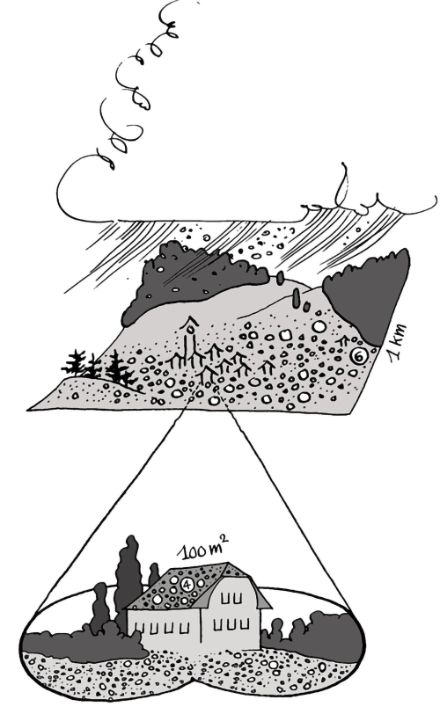Service Navigation
Search
Return periods of hailstone sizes
The maps show return values as a function of the return period T. They describe the hailstone size that is exceeded with a probability of 1/T per year under today's climate conditions, at a fixed location.
A frequently used return period is 100 years. However, a "100-year event" is often misinterpreted as one that occurs (only) exactly "once every 100 years". If the hailstone size determined for a 100-year event at a location is 4 cm, the estimated probability of observing a hailstone of 4 cm size at this location in each year is 1%. The probability that such a hailstone will occur at least once in a period of 30 years is still 26%. This is calculated according to the principles of probability theory: In any given year, there is a 99% probability that no 100-year event will occur (1-1/100 = 0.99); the probability that no 100-year event will occur over a 30-year period is 0.9930, or 74%. The probability that such a large hailstone occurs at least once in this time is the counter probability, i.e. 26%.
The return values of the hailstone sizes in Switzerland show a similar spatial pattern for all return periods: The maximum hailstone sizes per 1 km2 (MESHS) to be expected with the same annuality are larger in southern Ticino, the Napf region and along the Jura than in the mountain regions. In these three hail hotspots, the largest expected hailstones of 2-3 cm can be expected every second year, while these maximum hailstones occur statistically only every 20 years in the mountain regions of Grisons or Valais. If we look at rarer events of the 50-year return period, the picture is more uniform for the Central Plateau and southern Ticino - maximum hailstone sizes exceeding 6 cm must be expected here.
Due to the complex weather phenomenon of hail, the shortness of the data series from a climatological point of view, some technically induced measurement inaccuracies and statistical assumptions, the return values, especially of the long return periods, are subject to uncertainties that are widely in the range of 0.5 to 1 cm. The uncertainties with regard to long return periods are particularly large in regions in which hail has rarely or never been observed in the available data series. The mountainous regions are particularly noteworthy here. In the Alpine regions, the population and building density is also much lower, so that less historical data, insurance data or eyewitness reports are available as a reference.
From square kilometre to house roof
The hailstone size MESHS refers to the maximum hailstone within one square kilometre. However, the areas considered in practice are generally smaller: A single-family house, for example, might have a roof area of about 100 square metres, which is 10,000 times smaller than the reference area of MESHS (see Figure 2). From the user's point of view, MESHS is therefore not easy to apply.
In order to be able to estimate the actual hailstone size occurring on the scale of a house roof, a conversion was implemented. LEHA is derived from MESHS, which stands for "Largest Expected Hail on a reference Area". The development and validation of the conversion was supported by the hail reports from the MeteoSwiss app and data from the hail measurement network, as well as by case studies of damage events by the project partners.
The choice of reference area for LEHA is determined by the respective application. The transformation is done with a calculation rule and the LEHA diagram (see Figure 3). This derived quantity is particularly relevant for applications relating to damage to buildings and vehicles.


Figure 2: The figure illustrates the difference between MESHS and LEHA. The radar product MESHS refers to the scale of one square kilometre. The probability that the largest expected hailstone on a 1 km2 area will fall exactly onto a house roof or a vehicle is small. LEHA, on the other hand, refers to a smaller area, in this case a house roof of 100 m2. In the figure, the largest hailstone within the square kilometre has a diameter of 6 cm. From this, a diameter of 3.8 cm is derived for LEHA-100 according to the LEHA diagram (figure below). Although a hailstone with a diameter of 6 cm could occur somewhere within the square kilometre, one would expect a hailstone of just under 4 cm for the area of a house.

Figure 3: The figure shows a schematic diagram of the LEHA calculation rule. MESHS indicates the diameter of the largest possible hailstone within one square kilometre. The LEHA diagram allows transformation to smaller reference areas. LEHA-100, for example, indicates the largest hailstone size to be expected on an area of 100 m2. Let us assume a MESHS value of 6 cm. From this we derive a LEHA-100 of 3.8 cm.
